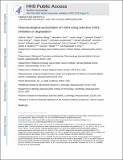Pharmacological perturbation of CDK9 using selective CDK9 inhibition or degradation
Author(s)
Olson, Calla M; Jiang, Baishan; Erb, Michael A; Liang, Yanke; Doctor, Zainab M; Zhang, Zinan; Zhang, Tinghu; Kwiatkowski, Nicholas; Boukhali, Myriam; Green, Jennifer L; Haas, Wilhelm; Nomanbhoy, Tyzoon; Fischer, Eric S; Bradner, James E; Winter, Georg E; Gray, Nathanael S; Young, Richard A.; ... Show more Show less
Downloadnihms933263.pdf (1.075Mb)
PUBLISHER_POLICY
Publisher Policy
Article is made available in accordance with the publisher's policy and may be subject to US copyright law. Please refer to the publisher's site for terms of use.
Terms of use
Metadata
Show full item recordAbstract
Cyclin-dependent kinase 9 (CDK9), an important regulator of transcriptional elongation, is a promising target for cancer therapy, particularly for cancers driven by transcriptional dysregulation. We characterized NVP-2, a selective ATP-competitive CDK9 inhibitor, and THAL-SNS-032, a selective CDK9 degrader consisting of a CDK-binding SNS-032 ligand linked to a thalidomide derivative that binds the E3 ubiquitin ligase Cereblon (CRBN). To our surprise, THAL-SNS-032 induced rapid degradation of CDK9 without affecting the levels of other SNS-032 targets. Moreover, the transcriptional changes elicited by THAL-SNS-032 were more like those caused by NVP-2 than those induced by SNS-032. Notably, compound washout did not significantly reduce levels of THAL-SNS-032-induced apoptosis, suggesting that CDK9 degradation had prolonged cytotoxic effects compared with CDK9 inhibition. Thus, our findings suggest that thalidomide conjugation represents a promising strategy for converting multi-targeted inhibitors into selective degraders and reveal that kinase degradation can induce distinct pharmacological effects compared with inhibition.
Date issued
2017-12Department
Massachusetts Institute of Technology. Department of BiologyJournal
Nature Chemical Biology
Publisher
Nature Publishing Group
Citation
Olson, Calla M et al. “Pharmacological Perturbation of CDK9 Using Selective CDK9 Inhibition or Degradation.” Nature Chemical Biology 14, 2 (December 2017): 163–170
Version: Author's final manuscript
ISSN
1552-4450
1552-4469